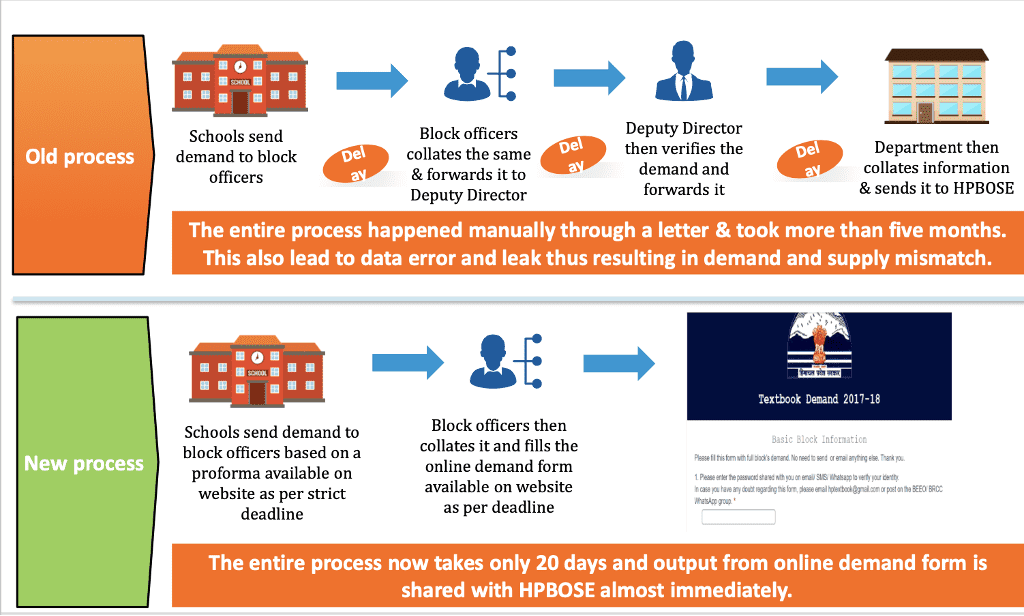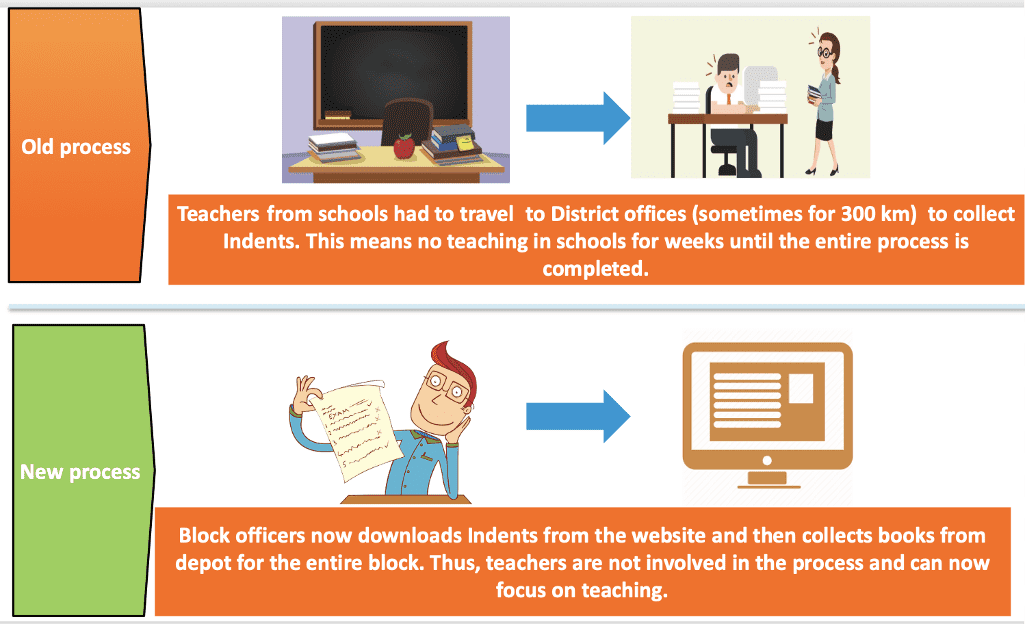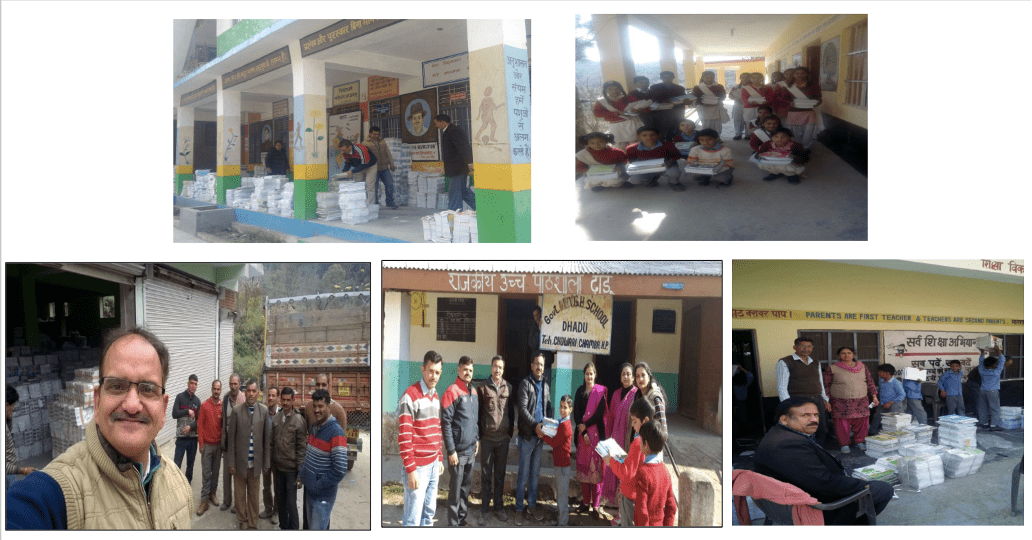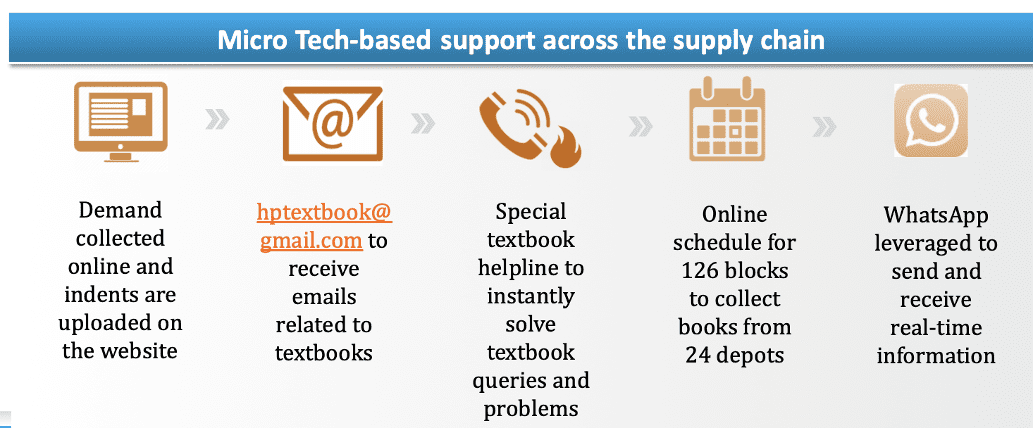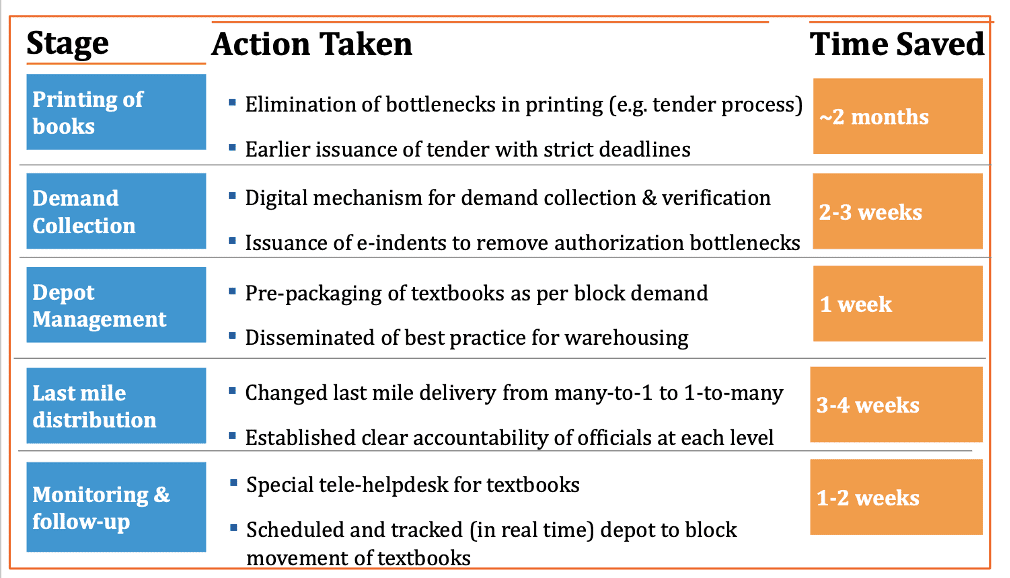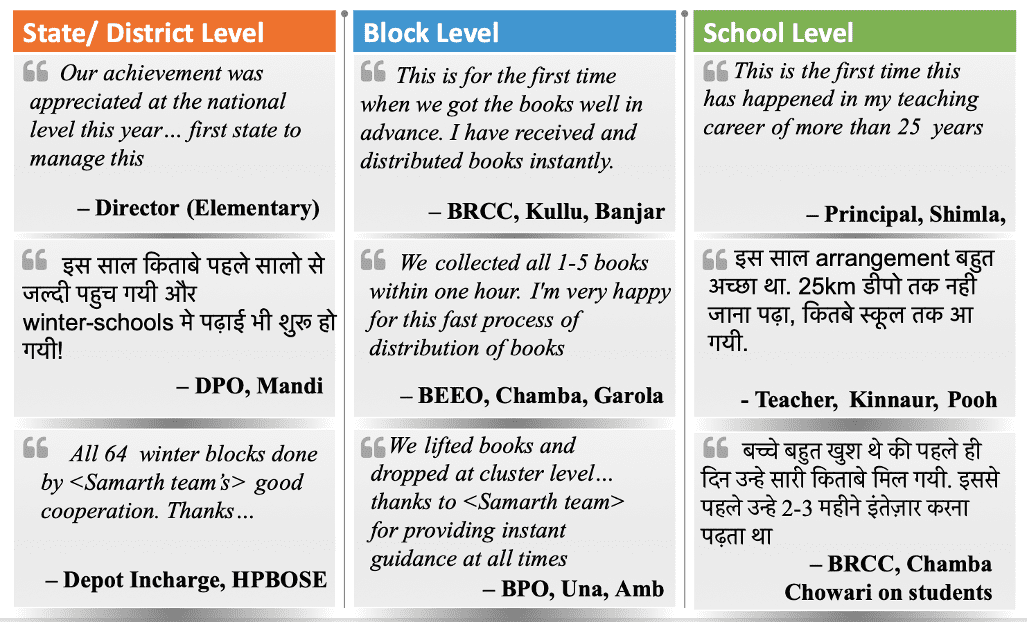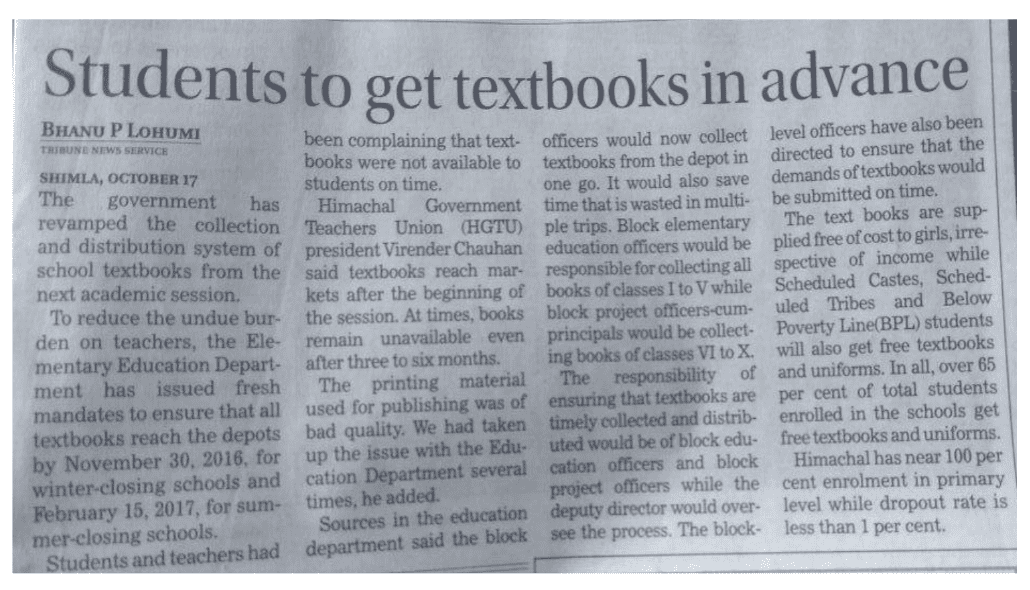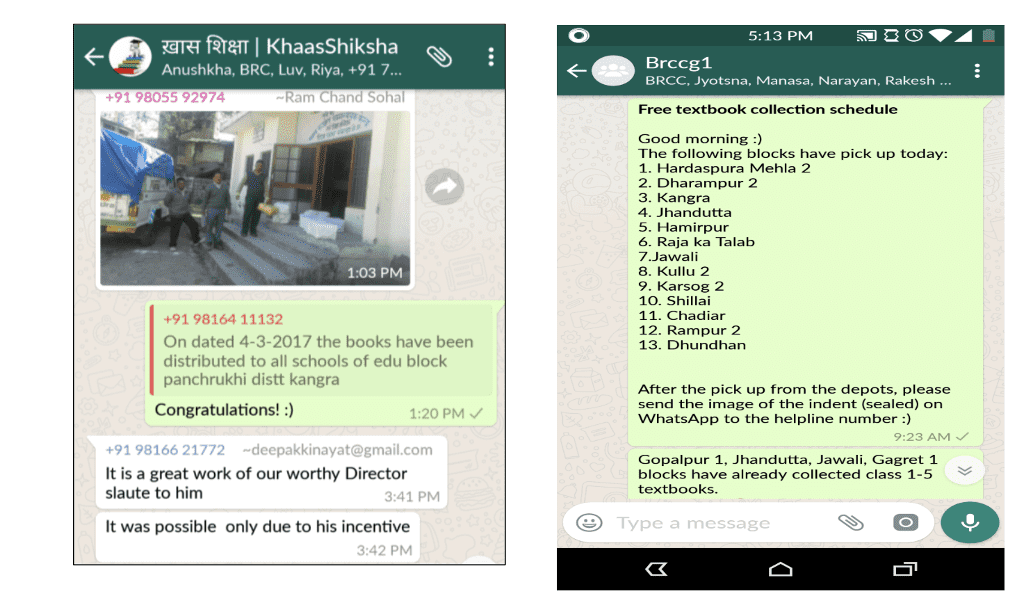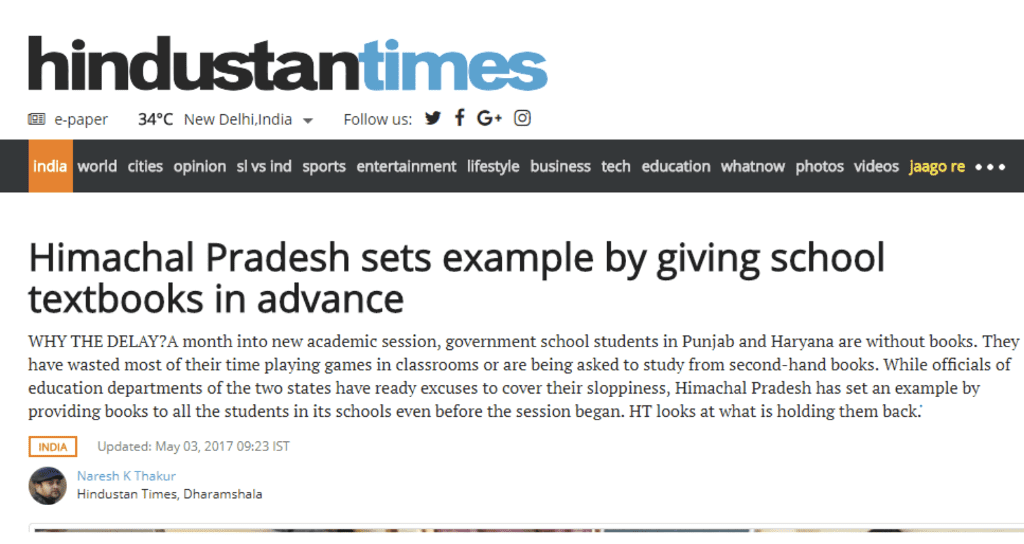In the picturesque yet challenging terrain of Himachal Pradesh, ensuring access to education is no easy task. Among the challenges faced by the state's education system consisting of 15,000+ government schools catering to 6 Lakh+ students, the timely delivery of textbooks to government school students was a pressing concern. For years, delays in textbook distribution—averaging 2.5 months—deprived students of crucial learning time, disrupted academic schedules, and created unnecessary burdens for teachers and administrators. Recognising the urgency of the issue, the Himachal Pradesh government, with the support of Samagra, launched a systemic intervention to ensure timely textbook delivery, under the Samarth Himachal Pradesh programme. This initiative transformed a historically inefficient supply chain into a robust, tech-enabled process, ensuring textbooks reached over 6 lakh students on time.
The Challenge: A Strained Supply Chain
Fig 1: Old process of textbook delivery
Teachers were among the most affected by the inefficiencies in the textbook supply chain. Their roles, meant to focus on imparting education, were significantly hampered by logistical and administrative burdens:
- Administrative Burden of Demand Collection: Teachers were tasked with manually submitting textbook demand forms to district officials. This process often required extensive paperwork, consuming time that could otherwise be devoted to lesson planning and teaching.
- Logistical Struggles for Collection: Once textbooks were available, teachers had to travel to depots—sometimes over long distances and difficult terrain—to collect them. This not only disrupted their teaching schedules but also added physical and mental strain.
- Condensed Teaching Timelines: With delays averaging 2.5 months, teachers were left with only eight months to complete a ten-month curriculum. This led to rushed instruction, reduced depth in teaching, and ultimately, a compromised learning experience for students.
Department officials at various levels also faced significant challenges due to the systemic inefficiencies in the textbook supply chain:
- Manual and Fragmented Processes: Without a centralised tracking or demand collection system, officials struggled to consolidate data from multiple sources. Managing physical indents submitted by 15,000+ schools was time-consuming and prone to errors.
- Coordination Failures Across Stakeholders: Poor communication and unclear roles among government officials, printers, and depot managers often led to bottlenecks at multiple stages of the supply chain, delaying the process further.
- Resource and Time Drain: The lack of digital infrastructure meant officials had to dedicate substantial time to resolving supply-demand mismatches and addressing grievances, detracting from their ability to focus on broader administrative and strategic responsibilities.
These challenges underscored the urgent need for systemic changes, one that would alleviate burdens on both teachers and department officials while ensuring timely textbook delivery to students.
The Solution: A Systemic Transformation
The Department of Elementary Education, Himachal Pradesh government, in collaboration with Samagra, took a holistic approach to reform the textbook delivery process. The intervention targeted every stage of the supply chain, introducing technology, redefining roles, and streamlining operations to ensure efficiency and accountability.
Digitising Demand Collection
The first step was addressing the inefficiencies in demand collection. Previously, schools manually submitted forms, leading to delays and inaccuracies. The new system replaced this with a centralised online demand collection process. Schools now submitted their requirements via an online form hosted on the HPBOSE website, adhering to strict deadlines. Block officers verified these submissions digitally, and the consolidated data was shared with HPBOSE almost instantly. This shift reduced the demand collection timeline from five months to just 20 days.
Fig 2: Comparison of old and new process
Redefining Depot Operations
Depot operations were a critical bottleneck in the old system. To expedite processing, the government introduced electronic indents (e-indents), which block officers could download directly from the online system. These e-indents streamlined the process, allowing depots to prepare pre-packaged book bundles for each block. This approach not only minimised errors but also significantly reduced the time block officials spent at depots.
Fig 3: Challenges addressed through the introduction of e-indents
Early Printing and Penalties
Recognising that delays in printing were a major contributor to late textbook delivery, the government advanced the tendering process for printers by two months. This ensured that textbooks were ready well before the start of the academic year. To enforce accountability, stringent penalties of up to 10% were imposed on printers for delays, incentivising adherence to deadlines.
Streamlined Last-Mile Delivery
The last-mile delivery process underwent a complete transformation. Previously, teachers were responsible for collecting textbooks from depots, which disrupted their teaching schedules. The new system shifted this responsibility to block officials, who distributed the books to clusters and schools. This change not only relieved teachers of logistical duties but also improved the overall efficiency of the delivery process. The last-mile delivery process was changed from many-to-one to one-to-many, improving efficiency by 40%.
To further streamline operations, depots began preparing book bundles in advance, categorised by block requirements. This reduced turnover time at depots by 30%, ensuring quicker delivery to schools.
Fig 4: Images from book depots and schools from the book delivery process
Leveraging Technology for Transparency and Accountability
Technology played a pivotal role in ensuring transparency and accountability throughout the supply chain. SMS alerts and reminders were sent to stakeholders at every stage to ensure adherence to timelines. A tele-helpdesk was established to address queries and provide real-time support.
An online dashboard offered end-to-end visibility into the textbook delivery process. Stakeholders could track the movement of books from depots to blocks and clusters, ensuring transparency. Additionally, delivery confirmations were collected via Interactive Voice Response System (IVRS) calls, ensuring that every school received its textbooks.
Fig 5: Micro-tech enablements utilised for the textbook delivery process
Data-Driven Redistribution
To address mismatches in demand and supply, the government employed data analytics to forecast requirements and redistribute surplus stock. This ensured that every school received the exact number of textbooks needed, minimising wastage and shortages.
Impact: Himachal Pradesh Sets a National Benchmark
Fig 6: Efficiency Gains from various aspects of the solution
The impact of these interventions was transformative, setting a new standard for textbook delivery in India. By the 2018 academic session, Himachal Pradesh had successfully delivered 55 lakh textbooks to 15,000 schools before the start of the academic year. The average delay of 2.5 months was eliminated entirely, ensuring that students began their studies with the required materials in hand.
Teachers, previously burdened with logistical responsibilities, were now free to focus entirely on their classrooms. This shift allowed them to dedicate more time to teaching and improved their ability to complete the curriculum on schedule. The availability of textbooks from day one of the academic year also enhanced the learning experience for students, enabling uninterrupted education.
Accountability among stakeholders improved dramatically. Clearly defined roles and responsibilities, coupled with continuous monitoring, fostered a culture of ownership. The use of technology ensured transparency at every stage, building trust in the system and reducing the potential for delays or errors.
One of the most significant achievements of the initiative was its sustainability. The restructured system became institutionalised within the education department, ensuring that timely textbook delivery would continue without external intervention. Himachal Pradesh’s success not only addressed an immediate issue but also created a replicable model for other states to follow.
Fig 7: Reflections from stakeholders on the success of the intervention
Operationalising Success: A Closer Look
The success of the Timely Textbook Delivery initiative can be attributed to meticulous planning and execution. Workshops were held with stakeholders, including teachers, block officials, and depot managers, to align them with the new processes and timelines. Training sessions equipped stakeholders with the skills needed to use the new systems effectively.
Fig 8: Images from workshops held with stakeholders
To maintain momentum, the government introduced incentives and penalties. Officials who performed well were publicly recognised, while non-compliance resulted in disciplinary action. Media coverage of the initiative further reinforced its importance, creating external pressure to meet deadlines.
Fig 9: Coverage from the tribune on HP setting a goal to deliver textbooks before the start of the academic year
The system’s success was also bolstered by micro-level interventions. For instance, WhatsApp groups were created to share real-time updates, schedules, and confirmations. Photos of sealed book bundles were sent as proof of delivery, adding an additional layer of accountability. These low-cost, high-impact measures ensured smooth operations even in the most remote areas.
Fig 10: Whatsapp Groups being used for real-time updates
Reflections and Future Implications
Fig 11: Coverage from national media houses on the success of the intervention
The Timely Textbook Delivery initiative exemplifies how systemic reforms can address inefficiencies in public systems. By leveraging technology, redefining roles, and fostering accountability, Himachal Pradesh transformed a once-broken system into a model of efficiency and equity.
This success has broader implications for governance in education. Similar approaches can be applied to other states facing textbook delivery challenges or to other sectors where supply chain inefficiencies hinder service delivery. Himachal Pradesh’s journey demonstrates the power of collaboration between government and organisations like Samagra in driving meaningful change.
As Samagra continues to partner with governments across India, the lessons from this initiative serve as a blueprint for systemic transformation. In Himachal Pradesh, the timely delivery of textbooks has not only improved learning outcomes but has also reaffirmed the importance of governance in ensuring equitable education for all.
This blog is part of the Amrit Series, where we bring to you success stories of large scale impact through our work across domains and states. You can learn more about Timely Textbook Delivery here.


